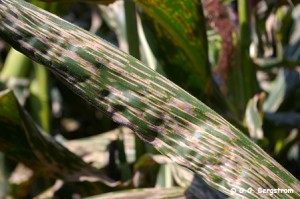Field corn is the king of crops in New York. This highest net-value and most widely grown crop occupies more than a million acres statewide. Some years it’s hammered by leaf blights that can cost considerably if not treated in time. Other years your fields get off almost unscathed.
How to know which conditions tip the scales for health or disease on your farm — and thus whether you should spray or put that money to a different use?

Savvy farmers who know the risks and benefits of pesticides need ways to tell whether a given fungicide will provide higher yields and profits, and under what conditions. To help them, IPM researchers have taught and tested new materials that help growers set up side-by-side strip trials — three or more pairs of treated and untreated corn, each strip at least 10 feet wide, so growers can do their own on-farm research.

After all, good judgment is the best tool farmers have — and the best place to hone it is in their own fields, under their growing conditions. There’s no better way to know which combination of pest-management tactics work best in the microcosm known as your farm, regardless what a specialist or sales person might say.
Find these new protocols on our website.